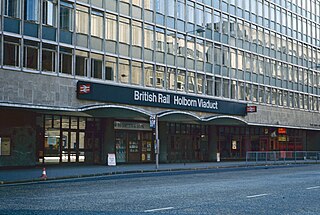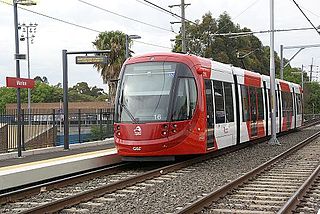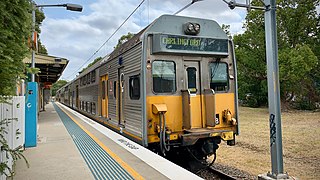
Farringdon is an interchange station located in Clerkenwell, London, England, in the London Borough of Islington, just outside the boundary of the City of London for London Underground, Elizabeth line and National Rail services.

Denmark Hill is an interchange station between the Windrush line of the London Overground and National Rail services on the Catford loop line, located in Denmark Hill in South London. It is 4 miles 22 chains (6.9 km) down the line from London Victoria. The station is located in Travelcard Zone 2 and is managed by Thameslink. The station receives services operated by Southeastern and Thameslink in addition to the London Overground.

Wynyard railway station is a heritage-listed underground commuter rail station located in the north-west precinct of the Sydney central business district, in New South Wales, Australia. The station opened on 28 February 1932 to coincide with the opening of the Sydney Harbour Bridge.

The Airport & South Line is a commuter rail service operated by Sydney Trains, connecting the Sydney central business district with the southwestern suburbs via Sydney Airport.

Holborn Viaduct was a railway station in the City of London, providing local and commuter services. It was located to the southeast of Holborn Viaduct, and east of Farringdon Street.

Newport is the second-busiest railway station in Wales. It is situated in Newport city centre and is 133 miles 13 chains (214.3 km) from London Paddington measured via Bristol Parkway, and 158 miles 50 chains (255.3 km) via Stroud.

Berkhamsted railway station is in the historic market town of Berkhamsted, Hertfordshire, England. It is located just beside Berkhamsted Castle, overlooking the Grand Junction Canal. The station is 28 miles (45 km) north west of London Euston on the West Coast Main Line. London Northwestern Railway operates services to London, Northampton and many other destinations.

Stanwell Park railway station is located on the South Coast railway line in New South Wales, Australia. It serves the seaside village of Stanwell Park opening on 23 December 1901, relocating to its current location on 10 October 1920.

Singleton railway station is a heritage-listed railway station located on the Main Northern line in New South Wales, Australia. It serves the town of Singleton. It was added to the New South Wales State Heritage Register on 2 April 1999.

Kidderminster railway station is the main station serving the large town of Kidderminster, Worcestershire, England and the wider Wyre Forest district. The station is operated by West Midlands Trains, and is on the Birmingham to Worcester via Kidderminster Line. Regular commuter services run to Birmingham and Worcester. It shares its station approach with the adjacent Severn Valley Railway station.

Waitākere railway station is a disused station on the North Auckland Line located in the village of Waitākere, to the north-west of Auckland, New Zealand. It served as the western terminus of the Western Line of the Auckland suburban network until July 2015, when services were restricted to Swanson and Waitakere Station was closed.

Maitland railway station is located on the Main Northern line in New South Wales, Australia. It serves the city of Maitland opening on in 1880 as West Maitland being renamed Maitland on 1 April 1949. It is the junction station for the Main Northern and North Coast lines. It was added to the New South Wales State Heritage Register on 2 April 1999.

Solihull railway station serves the market town of Solihull in the West Midlands of England. The station is served by West Midlands Trains and Chiltern Railways.

Bedminster railway station is on the Bristol to Exeter line and serves the districts of Bedminster and Windmill Hill in Bristol, south-west England. It is 0.9 miles (1.4 km) to the west of Bristol Temple Meads, and 119 miles (192 km) from London Paddington. Its three letter station code is BMT. It was opened in 1871 by the Bristol and Exeter Railway, was resited slightly further to the west in 1884 and was rebuilt in 1932. The station, which has three through-lines and two island platforms, but minimal facilities, is managed by Great Western Railway who operates all train services that serve the station, mainly an hourly service between Avonmouth and Weston-super-Mare.

Shellharbour Junction railway station is a railway station located in Dunmore in the City of Shellharbour, New South Wales, Australia, on the Illawarra railway line. The station is served by NSW TrainLink South Coast Line trains traveling south to Kiama and north to Wollongong and Sydney. Premier Illawarra operates a connecting bus service from the station to Shellharbour.

The Cobar railway line is a railway line in New South Wales, Australia. It branches west towards Cobar from the Main West Line at Nyngan. Main West passenger trains once continued northwest to Bourke but no longer run past Dubbo. However, copper concentrates from mines near Hermidale and Cobar are still railed on this line to ports on the New South Wales coast.
The Parkes–Narromine railway line is a railway line in New South Wales, Australia. The line forms part of a cross-country route between Cootamundra on the Main South line and Werris Creek on the Main North line. It is owned by the Rail Infrastructure Corporation of New South Wales, but is managed and maintained by the Australian Rail Track Corporation under a 60-year lease signed in 2004. The line is used mainly for grain haulage, with several silo facilities located along the line. Passenger services ceased in the mid-1970s and there are no surviving passenger stations on the line. The station building at Peak Hill has been relocated to a nearby sportsground.

Orange railway station is a heritage-listed former railway bridge and now railway station located on the Main Western line on Paisley Street, Orange in New South Wales, Australia. It was built from 1877 to 1950. It is also known as Orange Railway Station and yard group. The property was added to the New South Wales State Heritage Register on 2 April 1999.

The Inner West Light Rail is a 12.8-kilometre (8.0 mi) light rail line in Sydney, New South Wales, Australia, running from Central railway station through the Inner West to Dulwich Hill and serving 23 stops. It was the original line of the Sydney light rail network. Services on the line are branded as the L1 Dulwich Hill Line since 2014.

The Carlingford railway line is a former heavy rail line in Sydney, New South Wales, Australia. It was opened from Clyde to Subiaco in January 1885, then by means of the construction of a bridge across the Parramatta River, to Carlingford in April 1896. It closed on 5 January 2020 with most of the line converted to be part of Parramatta Light Rail which opened in December 2024. A short section of the line was retained for use by Sydney Trains.




















